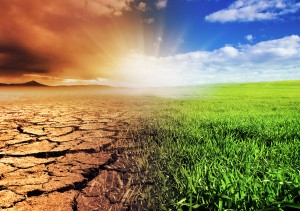According to a new White House National Climate Assessment report, the United States is already experiencing the effects of global warming (or climate change). Financial experts say that the change is climate is causing more than environmental threats, but also a risk to your pocketbook.
CNBC is reporting that Jodie Gunzberg, global head of commodities at S&P Dow Jones Indices, wrote that there can be a correlation between rising temperatures and price increases. For instance, more than four-fifths of the temperature increase has transpired since 1980 and in that timeframe there has been serious price hikes.
Pointing to the S&P GSCI Agriculture Index, Gunzberg noted that there has been an average increase of 16 basis points per each summer quarter and this could very well be the result of climate change.
 When prices are analyzed at the grocery store, the final receipt becomes a lot more intricate. As has been reported on numerous occasions, food prices are grocery stores are rising exponentially, but Gunzberg believes a lot of this has to do with global warming. She stated that food companies have different mechanisms to ease price jumps.
When prices are analyzed at the grocery store, the final receipt becomes a lot more intricate. As has been reported on numerous occasions, food prices are grocery stores are rising exponentially, but Gunzberg believes a lot of this has to do with global warming. She stated that food companies have different mechanisms to ease price jumps.
“So an example is if we go to the grocery store and we see a label that says, ‘May contain soybean oil, canola oil or palm oil,’ the reality is that it contains the cheapest oil. And that’s substitution that keeps the prices down for everyday consumers like you and me,” said Gunzberg.
She further told the business news outlet that firms have improved means to “substitute crops from different regions so that it can help keep the prices of food down when we go shopping.”
What’s the solution for consumers? Well, shoppers don’t have to suffer from a lack of proper nutrition. Instead, investors should become proactive by going long with a basket of commodities in order to fight food inflation.
In March, the U.S. Department of Agriculture projected prices to increase this year by between 2.5 and 3.5 percent. For close to a decade now, food price inflation has actually been a lot higher than overall price inflation.
Since the year 2000, American consumers have experienced high price inflation, according to David Stockman, former Reagan budget director, who published a series of charts highlighting this very fact. To understand how high price inflation has been for the past 14 years, here are some figures:
- Barrel of oil: $24.11 in Jan. 2000 | $100 in Mar. 2014 | 314.8 percent increase
- Gallon of gas: $1.27 in Jan. 2000 | $3.51 in Mar. 2014 | 176.4 percent increase
- Dozen eggs: $0.97 in Jan. 2000 | $2.00 in Mar. 2014 | 106.2 percent increase
- Movie ticket: $5.25 in Jan. 2000 | $10.25 in Mar. 2014 | 95.2 percent increase
- Postage stamp: $0.33 in Jan. 2000 | $0.49 in Mar. 2014 | 48.5 percent increase
Proponents of inflation usually cite shortages as being the reason behind price increases. However, as Henry Hazlitt wrote in his 1964 “What You Should Know About Inflation“:
“The same chain of causation applies to all the so-called ‘inflationary pressures’ — particularly the so-called ‘wage price spiral.’ If it were not preceded, accompanied, or quickly followed by an increase in the supply of money, an increase in wages above the ‘equilibrium level’ would not cause inflation; it would merely cause unemployment. And an increase in prices without an increase of cash in people’s pockets would merely cause a falling off in sales. Wage and price rises, in brief, are usually a consequence of inflation. They can cause it only to the extent that they force an increase in the money supply.”



